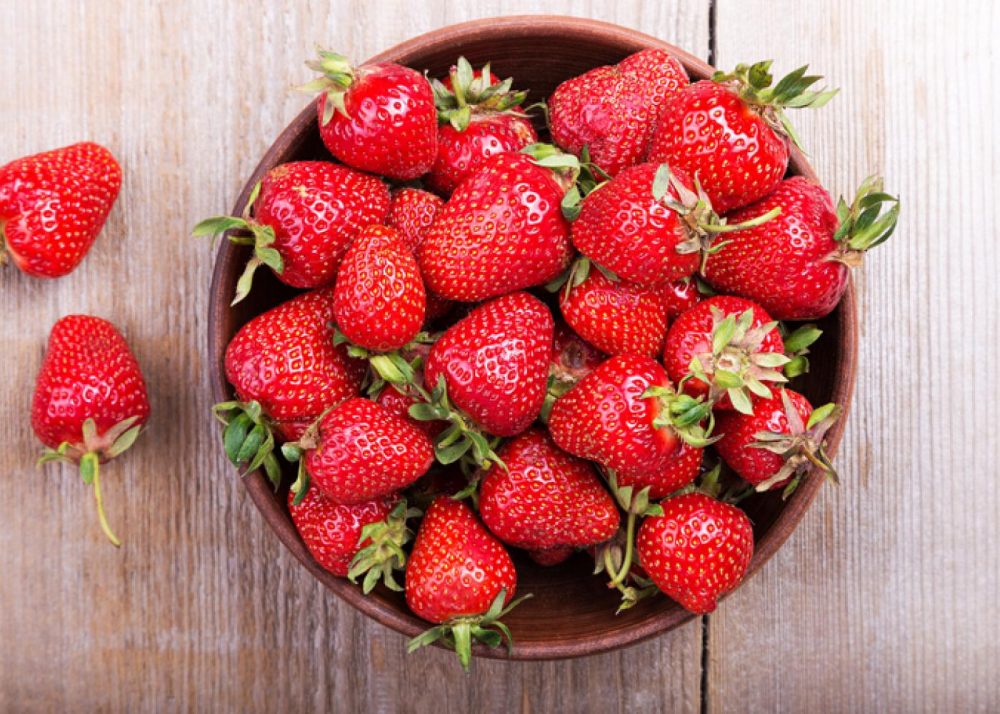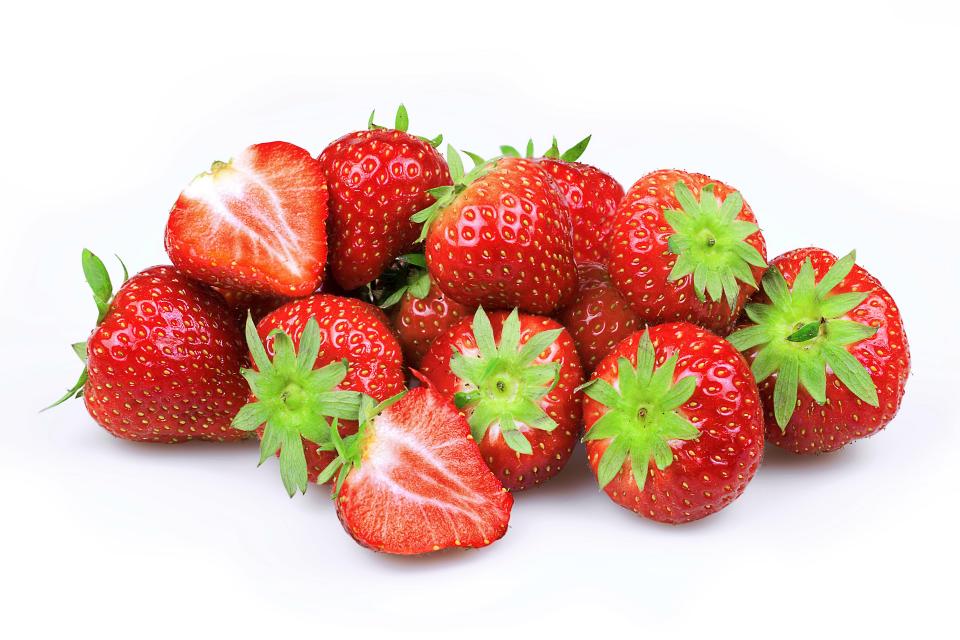27. Strawberries:

This is the most popular fruit eaten all over the world. They are made to prepare a number of culinary dishes like jams, ice creams, coulis, tarts, pies, milk shakes, etc.
Strawberries contain high vitamin C, manganese, and folic acid levels.
Red, juicy, delicious strawberries are one of the healthiest fruits to include in your diet. Strawberries are chockfull of antioxidants and other essential nutrients that can flavorfully help you reduce your risk of cancer, heart disease, inflammatory diseases, and birth defects as well as mouthwateringly manage your weight.
Dozens of studies over the past 20 years have associated diets high in fruit and vegetables with reduced risk of cancer. Recently, researchers have been testing individual foods for their cancer-fighting ability.
Studies examining the freeze-dried strawberries and strawberry extracts indicate that strawberries can fight breast, cervical and esophageal cancers. The compounds – such as antioxidants and other phytonutrients – found in strawberries (and other fruit and vegetables) are credited with health-protecting effects. Strawberries are a rich source of these antioxidants (vitamin C in particularly), flavonoids, and ellagic acid.
According to the California Strawberry Commission, a serving of strawberries (about 8 strawberries) provides 160 percent of the recommended daily intake for vitamin C. Further, vitamin C has been associated with reduced rates of stomach, cervical, breast and non-hormone-dependent cancers.
The flavonoids, such as anthocyanins, quercetin and kaempferol, exhibit antioxidant properties that have been proven beneficial in suppressing colon cancer cells, inhibiting prostate and breast cancer cancer cells, and inhibiting chemically-induced cancers of the lung, tongue, mouth, mammary and colon.
The antioxidant power of strawberries has been measured and scored by researchers of the United States Department of Agriculture (USDA) using the ORAC method. Strawberries score in the fruit group with the highest antioxidant values, or highest ORAC values. Strawberries are certifiably a super food! In addition, strawberries contain folate, a B vitamin that has been associated with reduced risk of several cancers as well as a decreased risk for birth defects, such as spina bifida.
A new analysis of data from the Harvard Women’s Health Study offers another potential link between strawberries and heart health. Researchers found that women with high strawberry consumption were more likely to also lead a healthy lifestyle.
The heart-health benefits of strawberries are attributed to their high levels of key nutrients. Vitamin C is an important antioxidant that has been correlated with lower death rates from cardiovascular disease, lower prevalence of cardiovascular disease and reduced risk of angina. Further, supplementation with vitamin C has been shown to reduce serum levels of C-reactive protein (a substance in the body that indicates the presence of injury or inflammation).
Folate is another nutrient in promoting heart-health – lower folate concentrations have been associated with increased coronary disease risk and increased fatal coronary events.

In addition to folate, strawberries are high in fiber and potassium, both associated with heart health benefits, such as lower cholesterol and blood pressure, respectively.
Maybe there is something truly fitting about heart-healthy strawberries being the preferred fruit for Valentine’s Day and other romantic encounters!
The direction of current research suggests that eating just eight strawberries a day can improve heart health, lower blood pressure, reduce inflammation, reduce the risk of cancers and even improve cognitive function. There is no reason not to eat strawberries as part of a healthy lifestyle. Strawberries are available nearly year round (though best in the summer), ripe for you to take advantage of the health benefits of this luscious, juicy fruit.
Researchers have recently ranked the 50 best antioxidant sources among commonly eaten foods and found strawberries to be quite exceptional. When total antioxidant capacity was measured against a uniform amount of food (100 grams, or about 3.5 ounces), strawberries ranked 27th best among U.S. foods. In addition, when only fruits were considered, strawberries came out 4th among all fruits (behind blackberries, cranberries, and raspberries). However, since many foods (for example, spices and seasonings) are seldom consumed in amounts as large as 3.5 ounces, researchers also looked at common serving sizes for all foods and their total antioxidant capacity. In this evaluation based on common serving sizes, strawberries came out 3rd among all U.S. foods including spices, seasonings, fruits, and vegetables! (In this analysis based on serving size, only blackberries and walnuts scored higher in total antioxidant capacity.) When we hear the word “strawberry,” we might think about a very commonplace fruit. But the antioxidant capacity of strawberry is anything but common!
Recent research has shown strawberries to be a surprisingly fragile, perishable, and delicate fruit. Food scientists recently took a close look at storage time, storage temperature, storage humidity, and degree of strawberry ripeness and found significant differences between different types of strawberry storage. On average, studies show 2 days as the maximal time for strawberry storage without major loss of vitamin C and polyphenol antioxidants. It’s not that strawberries become dangerous to eat or invaluable after 2 days.
It’s just that more storage time brings along with it substantially more nutrient loss. In terms of humidity, 90-95% has been shown optimal. Most refrigerators will average a much lower humidity (between 80-90%). Because air circulation inside the fridge can lower humidity, you may want to give your strawberries more storage humidity by putting them in your refrigerator’s cold storage bins (if available). Those cold storage bins will help boost humidity by reducing air circulation. If your fridge does not have storage bins, you can use a sealed container for refrigerator storage of your strawberries. Optimal temperature for strawberry storage over a 2-day period has been found to be relatively cold—36F (2C).
All public health organizations recommend refrigerator temperatures of 40F (4.4C) as the maximum safe level for food storage. However, if you are storing sizable amounts of fruits and vegetables—including strawberries—in your refrigerator, you may want to consider setting your refrigerator to a lower-than-maximum temperature setting in the range of 36-38F (2-3C). In terms of ripeness, recent studies have found that both underripeness and overripeness can have an unexpectedly large impact on the phytonutrient content of strawberries, especially their antioxidant polyphenols. Fortunately, optimal strawberry ripeness can be judged by color. You’ll want to consume your strawberries when their amazing pinkish-red color is most vibrant and rich in luster.

Improved blood sugar regulation has been a long-standing area of interest in research on strawberries and health. However, scientists have recently discovered a fascinating relationship between intake of strawberries, table sugar, and blood sugar levels. As you might expect, excess intake of table sugar (in a serving size of 5-6 teaspoons) can result in an unwanted blood sugar spike. But you might not expect this blood sugar spike to be reduced by simultaneous consumption of strawberries! Yet that’s exactly what researchers have discovered. With the equivalent of approximately one cup of fresh strawberries (approximately 150 grams), blood sugar elevations from simple sugar intake can be reduced.
These health science researchers have further speculated that polyphenols in strawberries played a major role in helping regulate blood sugar response. This finding is great news for healthy persons wanting to maintain healthy blood sugar levels, and also for persons with type 2 diabetes who enjoy fresh strawberries and want to enjoy them on a regular basis.
Given their amazing combination of phytonutrients—including anthocyanins, ellagitannins, flavonols, terpenoids, and phenolic acids—it’s not surprising to find increasing research interest in the anti-inflammatory properties of strawberries. But it’s still exciting to see this remarkable fruit lowering levels of inflammatory markers like C-reactive protein (CRP) when consumed several days per week in everyday amounts of approximately one cup. Recent research has shown that several blood markers for chronic, unwanted inflammation can be improved by regular intake of strawberries. Interestingly, in one large-scale study, consumption of strawberries did not show anti-inflammatory benefits until strawberries were consumed at least 3 times per week. This research is one of the reasons we recommend inclusion of berries at least 3-4 times per week in your overall fruit intake.
Disclaimer
The Content is not intended to be a substitute for professional medical advice, diagnosis, or treatment. Always seek the advice of your physician or other qualified health provider with any questions you may have regarding a medical condition.